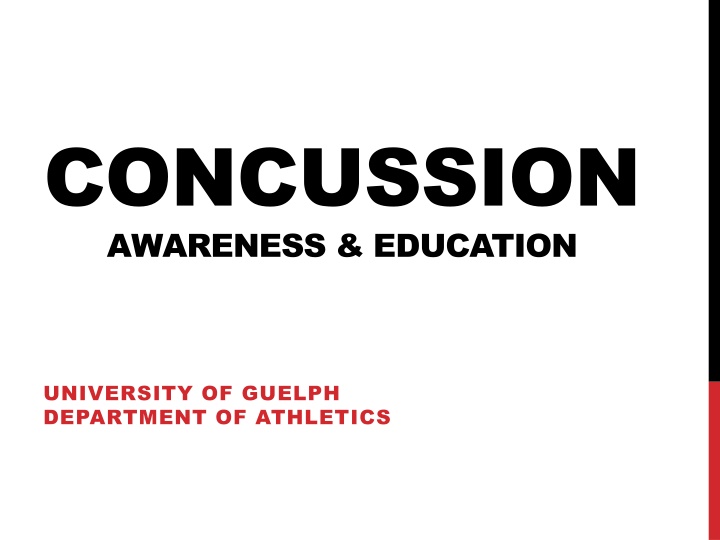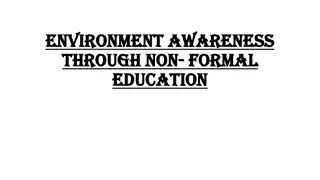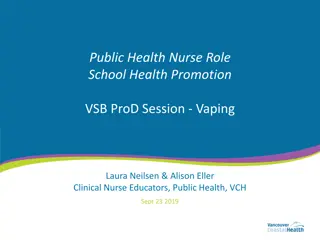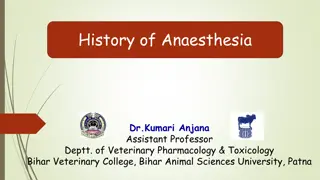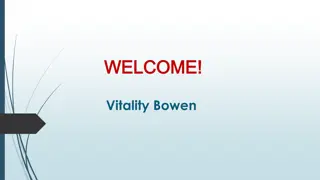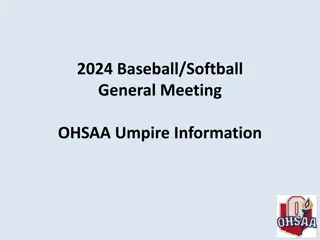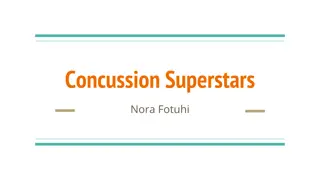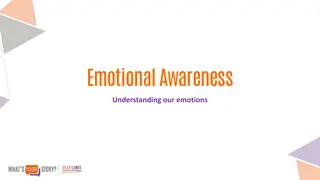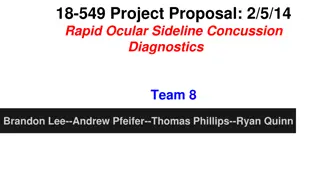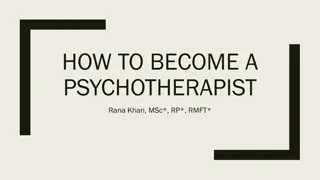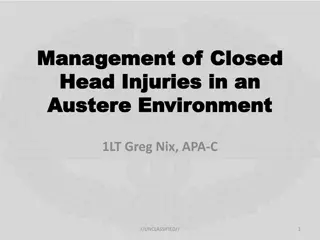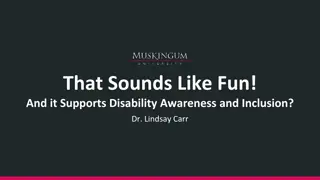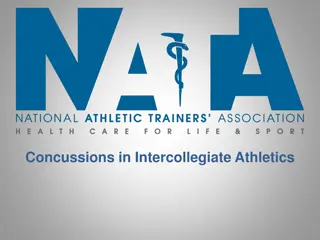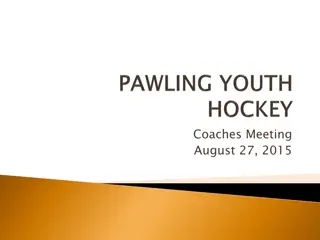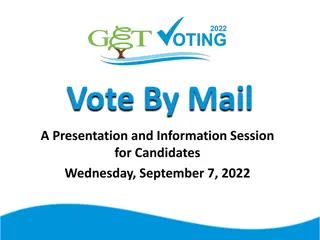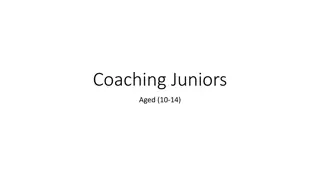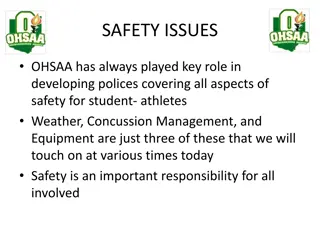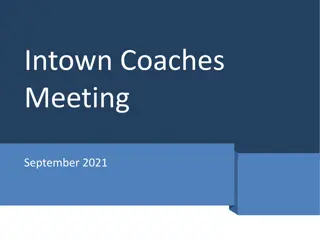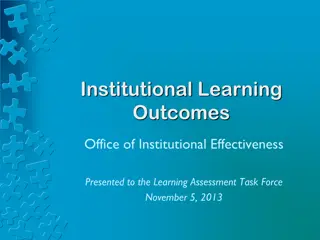Concussion Awareness and Education at University of Guelph
A concussion is a form of head injury that occurs due to a direct or indirect hit to the head or body, causing the brain to shift within the skull. It is a transient neurological event with a course of complete recovery in most athletes. Despite no accurate biomarker, it is diagnosed clinically based on symptoms and behavior. Visual signs include confusion and blank stares, while common symptoms range from dizziness to fatigue. Recognizing a concussion involves assessing if the brain was jarred and if any symptoms are present.
Download Presentation

Please find below an Image/Link to download the presentation.
The content on the website is provided AS IS for your information and personal use only. It may not be sold, licensed, or shared on other websites without obtaining consent from the author.If you encounter any issues during the download, it is possible that the publisher has removed the file from their server.
You are allowed to download the files provided on this website for personal or commercial use, subject to the condition that they are used lawfully. All files are the property of their respective owners.
The content on the website is provided AS IS for your information and personal use only. It may not be sold, licensed, or shared on other websites without obtaining consent from the author.
E N D
Presentation Transcript
CONCUSSION AWARENESS & EDUCATION UNIVERSITY OF GUELPH DEPARTMENT OF ATHLETICS
BACKGROUND A concussion is a form of head injury caused by a direct or indirect hit to the head or body that results in the brain shifting within the skull .
BACKGROUND It is a transient neurological event followed by a course of complete recovery over a relatively short period of time and return to normal activity, without any complications in the overwhelming majority of athletes .
BACKGROUND First concussion is a biochemical injury to the nerve connections (axons). Circuits not working . Brain cells remain in a vulnerable state in the days following a concussion.
BACKGROUND No accurate biomarker yet (MRI, blood test, x-ray, C-T scan, etc.) It is a clinical diagnosis (how you feel and act)
BACKGROUND MYTH: You do have to lose consciousness in order to suffer a concussion.
VISUAL SIGNS Confusion in motion. in response to questions. Blank or vacant stare. Sometimes losses consciousness.
COMMON SYMPTOMS Dizziness. Persistent headache or head pressure. Nausea or vomiting. Sensitivity to light or sound. Foggy thinking. Balance problems. Concentration problems. Fatigue.
SYMPTOMS There are 60 identified concussion symptoms. An athlete with a concussion could have anywhere from 1 to 23 different symptoms (Mean average of 8.1 symptoms).
SYMPTOMS Symptomology may not be noticeable for hours or days after the incident.
HOW DO I I RECOGNIZE A CONCUSSION? 1. Did I have an event that jars or shakes my brain? 2. Do I have any one or any combination of concussion symptoms?
INITIAL MANAGEMENT 1) Standard first aid principles: Rule out with an open head injury or closed head injury If you suspect you may have a concussion (mechanism or symptoms): a) Remove yourself from the field of play immediately b) Seek medical attention and REST (remove all screen activities, mentally and physically rest)
INITIAL MANAGEMENT After being symptom free for 48 hours a five stage, graduated return to play protocol is initiated. One stage is completed at the rate of one stage per day. If symptoms return at any time during the process, you return to the start of the process.
INITIAL MANAGEMENT #2) First 24-48 hours, physical and mental (study, computer/phone screens, videos) rest. Followed by gradual addition of activity. #3) Hydrate well.
RECOVERY There is no drug or other therapy to accelerate recovery from concussion (Dr. Charles Tator) REST is the only general strategy proven to help. 1. Do not tough it out . Ignore your general athletic voice telling you to ignore your symptoms.
FORMAL 5 DAY RETURN- TO-SPORT STRATEGY After Symptom-free stage Day 1 Light Aerobic Exercise 2 Moderate Exercise 3 Sport Exercise 4 Practice without contact risk 5 Full Practice
STATISTICS 85% of concussions resolve in 7-10 days. Of the 15% remaining, 3-5% of them will have bad/poor resolutions (symptoms lasting 3 months or longer). On rare occasions, returning to play while still having symptoms, has resulted in death (Second Impact Syndrome Rowan s Law in Ontario).
STATISTICS Of those who do not fully recover within one month 50% will have some form of mental health issue. Concussions are like snowflakes, no two are alike.
RETURN TO SCHOOL Start with HPC (Health and Performance Centre Sports Doctor) or physician at SHS (Student Health Services) and they will help you with academic concerns as well as your health concerns.
PREVENTION OF CONCUSSION 1. Follow the rules and regulations of your sport/activity. 2. Respect the well-being of your competitors. Do not take advantage of moments of vulnerability of your opponents. Be physical, not predatory.
SPORT AND RISK 1. Activities with No Risk is unrealistic. 2. Sport and Risk are natural partners. 3. Key is safe participation.
ROWANS LAW BILL 149 ONTGOVERNMENT Ontario is on the verge of becoming the first province/territory in Canada to pass a concussion law (virtually every state in the United States of America already has one). (Rowan Stringer was a female rugby player who sustained three separate concussions over a one week period and passed away shortly after the third one)
CTE CHRONIC TRAUMATIC ENCEPHALOPATHY DEMENTIA PUGILISTICA A neurodegenerative disease Accumulation of abnormal proteins in nerve cells in the brain. Resulting from multiple head injuries over a long period of time. Researchers finding it in autopsies of brains of former professional football/hockey players who showed, during life, signs of violence/crime, severe depression and suicide.
BRAIN CHANGES POST-CONCUSSION (2017 ST. MICHAELS HOSPITAL TORONTO) Found in university athletes with a history of concussion, changes in size, blood flow and connection in their brains months and even years after the injury. Particularly in areas of vision and planning.
RESOURCES 1. Concussion Awareness Training Tool (cattonline.com) 2. Parachute (parachutecanada.org) 3. Centers for Disease Control and Prevention (cdc.gov)
RESPECT 1. Your personal well-being and long-term health. If you suspect a concussion, remove yourself and access medical help. 2. Your team mates. If you suspect a team mate has suffered a concussion, let your coach, medical or para-medical personnel know. Look out for each other.
CONTACT Health and Performance Centre 2ndFloor Powell Building (519) 824-4120 x 53039 Student Health Services (519) 824-4120 x 52131 or daily Walk-In Clinic
